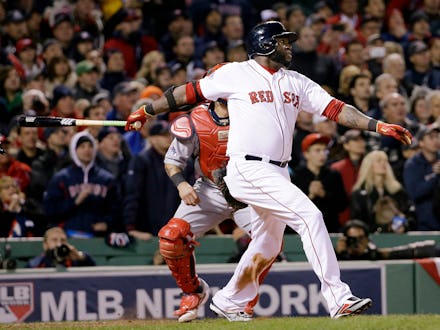World Series 2013 Ratings: Baseball Needs to Get Its Groove Back

It likely wasn’t the lopsided score that gave Wednesday night’s TV broadcast of Game 1 of the World Series a 28% ratings bump over last season’s poorly watched World Series. According to sportscaster-turned-pundit-turned-sportscaster-once-more Keith Olbermann, it had everything to do with the home team.
The closing monologue on Olbermann’s Thursday night show posited an interesting explanation for the notable decline in the Fall Classic's TV numbers: the loss of national teams. “The NFL spent the '50s and '60s trying to obtain something that baseball was desperate to get rid of: national teams. In the '50s there was a nationally televised baseball game of the week and then there was a nationally televised New York Yankees game of the week. And rather than appreciating what that meant — that there could be Yankees fans in Manhattan and in Manhattan, Kansas, and Manhattan, Nevada — baseball did everything it could to level the playing field.”
Game 1’s ratings success seemed to credit Olbermann’s argument. This year’s World Series features two of Major League Baseball’s most storied franchises, the Boston Red Sox and the St. Louis Cardinals. The Sox especially tend to draw national attention, their star-crossed history in tow whenever they take the field for a playoff game.
Then came Thursday night, and with it the third-worst rated Game 2 ever broadcast. So much for the “national team” theory.
A cursory look at the World Series’ TV ratings and viewership for the past 45 years demonstrates a problem larger than a lack of widely cheered teams like the Red Sox. The decline has been precipitous and steady from the highs of yesteryear, when, as the video notes, baseball was far and away the highest draw on television.
But what else was on television back then? Nothing!
“You know what else you could have watched that day [when Don Larsen pitched a perfect game in the 1956 World Series] on ABC?” Olbermann shouts. “ABC wasn’t on during the day.” The current series, of course, will go up against untold thousands of prime-time shows.
This all undoubtedly contributes to baseball’s low numbers, but it dances around the true issue in a circumlocution seen very often in sports media, but understood painfully well by thousands of baseball lovers like myself, and more painfully by the people in the rooms with us, forced to watch: Baseball is a super boring sport.
If you hate me for saying it, I feel your pain.
“Major League Baseball has managed to basically kill off what was not just this country’s greatest sporting event, but its ultimate non-political shared national experience.” Why must Olbermann try to pin the blame on poor, doddering Bud Selig? The only scandal he was involved in was the steroid era, which happened to be a better time for baseball’s viewership than the past decade.
No matter how many pyrotechnics Fox throws into the broadcast package, they still must contend with a three-hour game featuring action that totals 14 minutes, or 10% of the average broadcast time. Unlike football, which gets away with an even lower 11 minutes by featuring collisions and spectacular plays with more regularity, most of the “action” in baseball is a brief pitch-and-catch, serving only to add to the count. Then there’s the “great at-bat,” where the only "great" thing is the number of fouls the batter interminably hits — all of which serve as an excuse for him to step out of the box, walk around, adjust his cup, redo his gloves, and think about the next pitch.
There is a better suggestion than “national teams” for reviving baseball’s ailing prospects, and it addresses exactly this soul-consuming tedium. A movement started by sportswriters over the past few years has argued that Major League Baseball should reinstate a long-ignored rule stating that “the pitcher shall deliver the ball to the batter within 12 seconds after he receives the ball. Each time the pitcher delays the game by violating this rule, the umpire shall call ‘Ball.’”
Fantastic! According to one sportswriter who last year watched a game from 1985, this rule, when enforced, produced what sounds like a different sport. “Pitch, get the ball back from the catcher, a couple seconds to get the signal from the catcher for the next pitch, and pitch and repeat. Comparing how quickly he worked to the pace of the game today is staggering.”
If you’re within viewing distance this weekend, count the average time between pitches. It should be somewhere around 27 seconds. Imagine the pace being more than doubled.
That’s how the game used to be, when it was the national pastime.
Forget “national teams” and TV competition. Live sports are currently the last vestige of must-see TV (which is the reason baseball is actually doing fine in terms of TV money, if not ratings) and viewers would switch over from the cable dramas if the game were worth watching. The slow pace of modern-day baseball is the true culprit, and it could be fixed — not addressed, but fixed — simply by adhering to the existing rulebook.